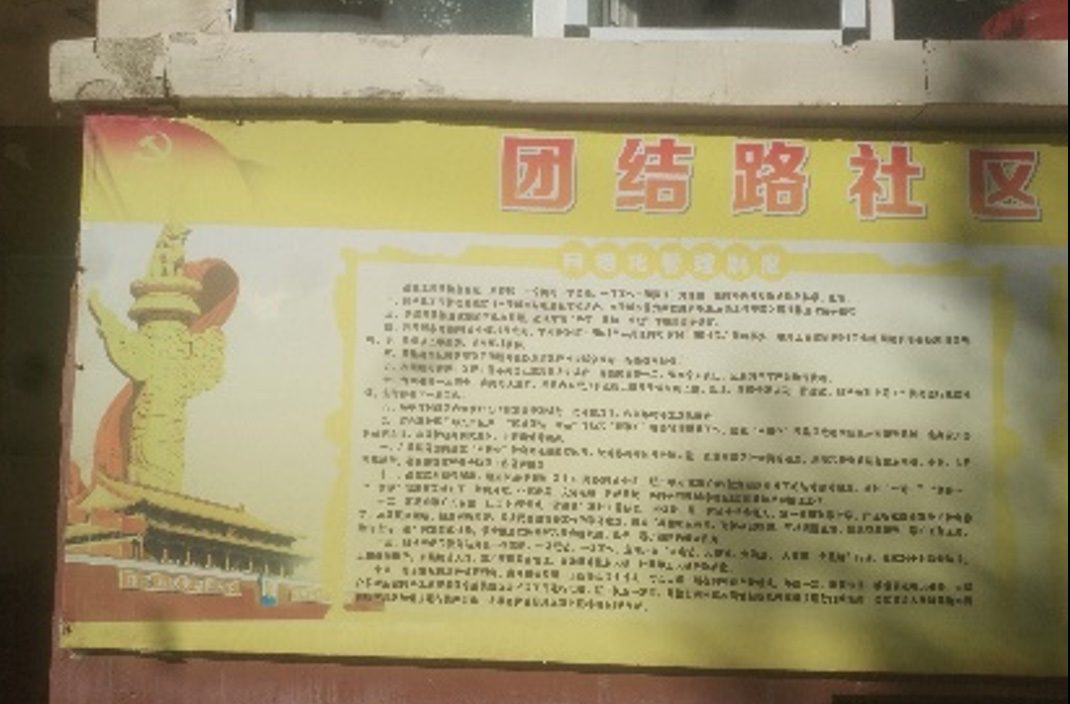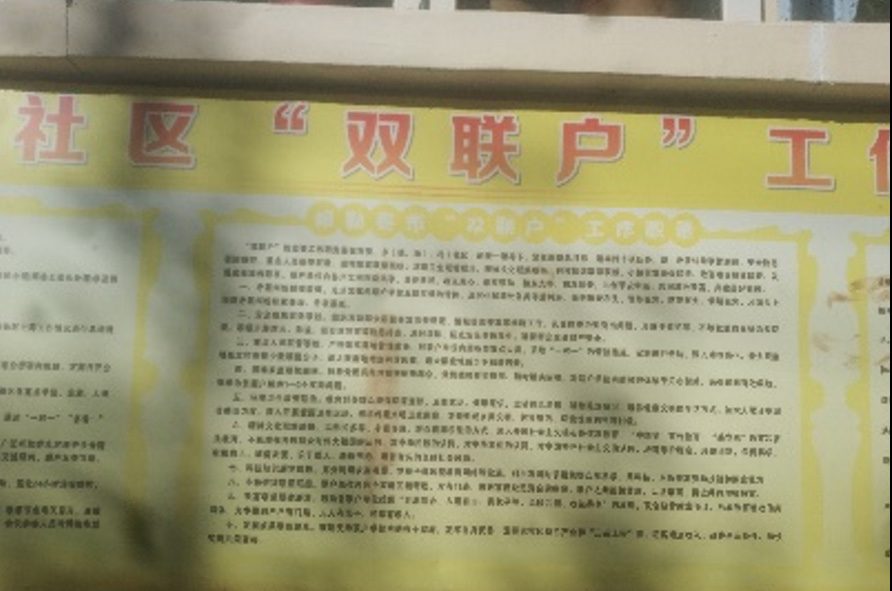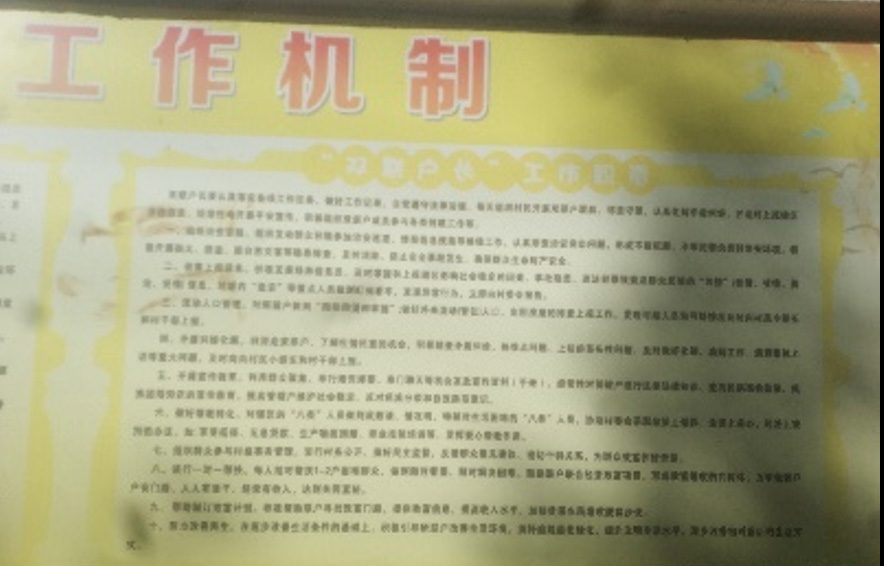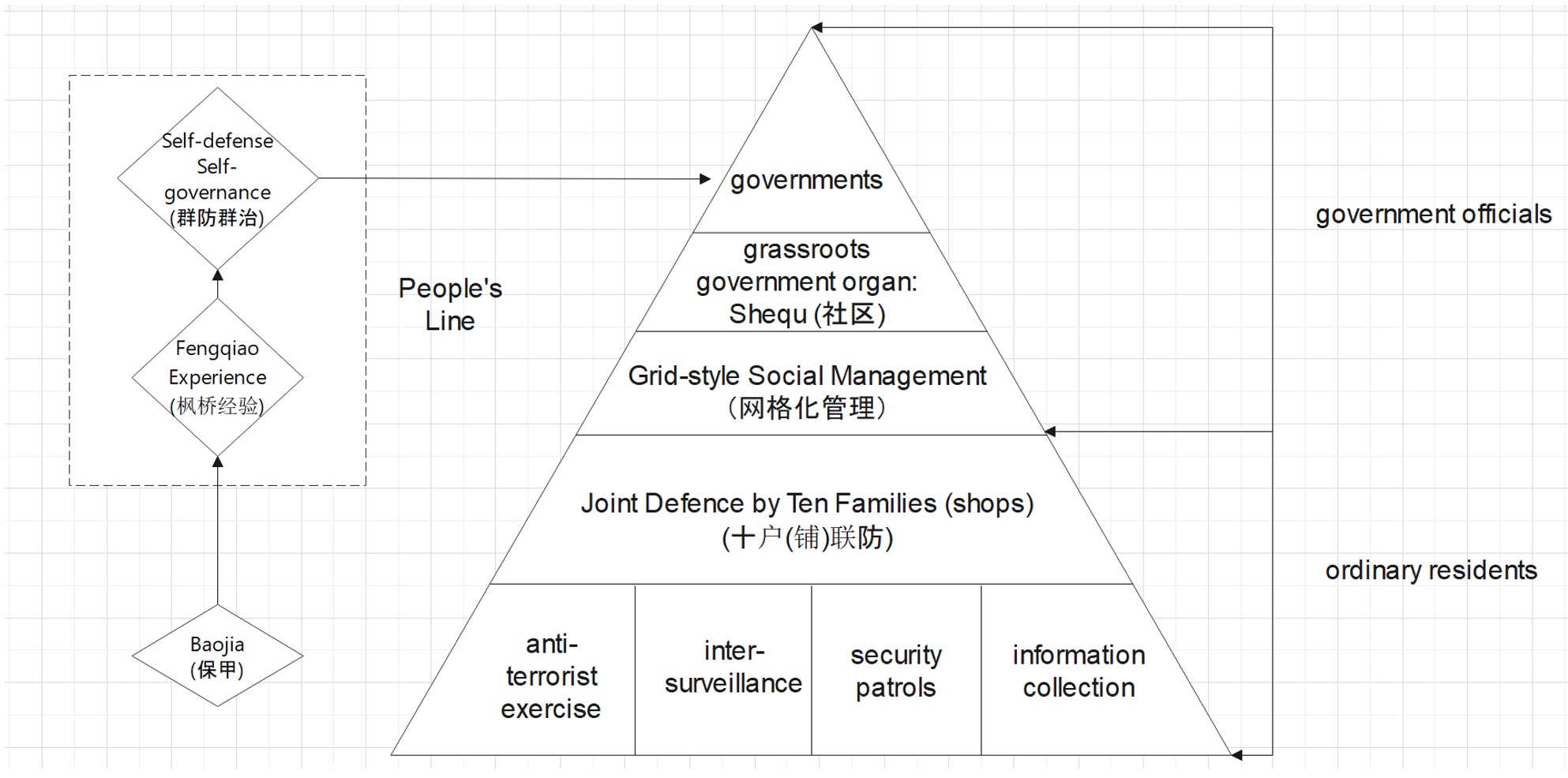Extending Grassroots Power and Mobilizing the People:
How the CCP Built a Pervasive Security System in Xinjiang
By Yao Qu
Figure 1: Posters reading “Work Mechanisms for ‘Joint Defence Households’ in Unity Road Neighbourhood”. Photos were taken by an individual in Altay, Xinjiang, 2020. For the English translation of the featured photographs, click here.
Extending grassroots governance in the XUAR: From danwei/shequ (Work Units & Neighbourhood Districts) to the shihu lianfang (Ten Family Joint Defence groups)
First, the grid leaders need to establish a mechanism with other security forces (e.g., neighbourhood districts, security stations, and the leader of the TFJD) to collect and analyze ‘enemies’ and societal information (敌社情).Second, they need to build a patrol system within their grids to arrange security patrols.
Third, they need to evaluate the leaders of the TFJD and coordinate issues with other grid leaders. Based on work performance, all grid leaders and crews are evaluated every year, from “one-star” to “five-stars.” Those who get two stars or below will be warned or fired, and those who get five stars will have a chance to be promoted (Y. Zhang, 2018).Within each grid, the CCP further developed the most pervasive security units in the current XUAR, called the Ten Family Joint Defence (TFJD) system, in some cases also named the Double Joint Defence (weiwen shuang lianhu维稳双联户) [3]. Based on proximity, every ten families (or local shops which are often family-run) are designated as one security unit to maintain stability in daily life (Li, 2020). On a daily basis, the TFJD is responsible for “ten tasks,” which include organizing security patrols and information collection, ‘transforming’ targeted people (重点人员) (that is, educating individuals identified as problematic by local authorities), and launching patriotic education. Members of the TFJD need to obtain and keep handy some ‘anti-terrorist’ tools (e.g., alarms, riot shields, helmets, and sticks) and practice ‘anti-terrorist’ combat every afternoon, guided by a local policeman. When one of the families/shops is attacked by ‘terrorists,’ the family can push an alarm that will inform the other nine families within the same security unit and the nearby police station (Li, 2020). Hence, before the policemen come, the ten families can first organize together to fight against the “terrorists.”Every security unit has a leader (十户长/双联户长) who is normally selected from among the families or shops (Pan, 2018). The leaders are responsible to mobilize other nine families to do security patrols. The leaders also need to cultivate informants (信息员) who can help collect “four situations” (四情): the enemy’s situation, societal situation, public opinion, and residents’ situation (敌情、社情、舆论、民情), and report these to the neighbourhood district who then reports to the corresponding police station. In terms of inter-surveillance, the leaders need to often “visit” other nine families or shops to detect “abnormal issues,” solve any local conflicts, educate the “focus” (problematic) people, and propagandize the CCP’s policies and ideas.From work units and neighbourhood districts to grids to the Ten Family Joint Defence groups, the CCP has been trying to extend its control over people at the grassroots level. Based on the ‘counterterrorism’ discourse, the CCP has mobilized ordinary people into this security work in the XUAR. Moreover, the government does not need to formally hire any members in the TFJD groups, thus saving the government budget. The TFJD system is, according to these Chinese studies, a ‘well-designed’ security system that is pervasive and effective but costs little money from the government. To understand the TFJD system, we need to examine the idea behind it, that is, mobilizing people against their neighbours.
The Philosophy of People Mobilization: from Baojia System to Self-defence Self-governance
The idea behind the TFJD system, which aims to mobilize ordinary people to keep an eye on their neighbours, is not a recent invention. On the contrary, the TFJD in the current XUAR is a product rooted in Chinese local governance from past centuries.In the Ming dynasty, a security system, called the Baojia system (保甲), was created to respond to the decline of social stability (Hu, 2014). This can be seen as the prototype of the TFJD. Similar to the current grassroots security system in the XUAR, the Baojia system also adopts decimal units (ten family units). In the Baojia system, every ten families are assigned as a “Jia,” which corresponds to the TFJD, every ten or five “Jia” a “Bao,” which corresponds to the grid in the XUAR. Apart from the decimal organization, the TFJD is also similar to the Baojia system in terms of security functions. In the Baojia system, families within the same Jia must surveil and support each other; if one family violates the laws, the other nine families within the same Jia will also be punished (Hu, 2014). In the TFJD, though all families are responsible for watching out and preventing the crimes of their neighbours, there is no evidence that they will be punished for the crimes committed by their neighbours. To the rulers in the Ming dynasty, the Baojia system not only could strengthen social stability at the grassroots level but also could save the government budget since no security forces were formally hired in the system.After the establishment of the PRC [4], the Baojia system and similar measures were abolished by the CCP, and CCP’s scholars have criticized baojia as a cruel control over people’s daily life (Zhao, 2017). Still, in 1963, a similar system was revived in Fengqiao County, Zhejiang Province, during a class struggle campaign to eliminate “four types of enemies” (including landlords, rich farmers, counter-revolutionaries, and “bad elements”). During the movement, the Fengqiao government mobilized the residents to catch, surveil, and “educate” such enemies, aiming to transform them into “new people” (新人) (Li, 2019). Mao Zedong highly approved of the Fengqiao experiment. He named it the “Fengqiao Experience” and promoted it across the country. Though not adopting decimal units, the idea behind Fengqiao Experience is close to the Baojia system, which emphasizes drawing on the people to work against themselves. The Fengqiao Experience requires that all security issues should be solved right on the spot by the people, which can improve social stability while saving the budget for the government.Since becoming the new president of the PRC in 2013, Xi Jinping has emphasized the “significant meaning” of Fengqiao Experience in the Mass Line (群众路线) and has required all party members and government officials to learn it (Xi, October 2013). In a meeting in 2014, Xi Jinping further came up with the “Self-defence, Self-governance” (群防群治) (Xi, April 2014), which can be seen as a manifestation of Fengqiao Experience in “counterterrorism” practice. Self-defence, Self-governance requires the government to organize the people into security units that can help solve conflicts and do security work (Zhang, 2014). As a working principle in public security, these Chinese studies emphasize that the core of Self-defence, Self-governance is to rely on the people themselves to solve security issues. In Chinese “counterterrorism” discourse, Xi Jinping (April 2014) described a security system based on Self-defence Self-governance that makes “terrorists” become “rats crossing the street that are attacked by everyone” (过街老鼠,人人喊打), which is a very vivid metaphor for the community self-enforcement of Self-defence Self-governance. In a meeting with the XUAR representatives in 2017, Xi Jinping emphasized that the XUAR government should “cling to Self-defence Self-governance, complete grid-style management, and achieve a solid security system that has no cracks, no blind or blank spots” (Li, 2020).
Figure 2: Grassroots Security System in the XUAR (author’s chart drawn from information in the articles covered in this report.)
Conclusion
Our conclusion based on reading these Chinese reports and my own fieldwork is that the TFJD, guided by Self-defence Self-governance policy, is a reproduction of the Baojia system and Fengqiao Experience in the ‘counterterrorism’ discourse in the XUAR. The idea behind it is to solve security issues by mobilizing people against each other, which has a long tradition in Chinese statecraft. The TFJD emerged in the XUAR as a result of three things: CCP’s efforts to extend its control at the grassroots level, the Party’s Mass Line policies, and CCP’s urge to handle ethnic issues in the XUAR as ‘a war on terror.’ Based on a ‘counterterrorism’ discourse, the CCP has mobilized all residents in the XUAR to ‘voluntarily’ engage in security activities, thus building a most pervasive security system at a relatively low cost. However, switching the cost from the government to the people has a potential to stir up the grassroots discontent since people’s daily life is disturbed by such activities without compensation (only the leaders can receive hundreds of Chinese Yuan as subsidies), and most even need to pay for the necessary equipment themselves. In theory, the TFJD is a perfect security system for the CCP since it is so pervasive and low-cost. But in practice, a security system that makes all residents unpaid laborers faces challenges in the long term.
Acknowledgment
Thanks to all members of the Xinjiang Documentation Project, especially Guldana Salimjan, Timothy Cheek, and Darren Byler, who provided me with valuable suggestions.
[1] As the Party secretary in Tibet from 2011 to 2016, Chen Quanguo had implemented the Double Joint Defence in Tibet, which works as the same as the TFJD. See: https://news.ifeng.com/a/20160829/49857646_0.shtml
[2] Here, 户 can refer to both a family’s home or a shop.
[3] In the Double Joint Defence, “double” refers to double duties: maintaining social stability and promoting unity and harmony (联户促社会稳定 联户促团结和谐). See: https://web.archive.org/web/20210730233421/http://www.bingtuannet.com/btrb_stdt/201910/t20191023_1811.html
[4] During the rule of the Republic of China (1912-1949), Guomindang also used Baojia system to maintain control.
References
Hu, H.F. (2014). The Deterioration of Beijing’s Public Security in Later Ming Dynasty and the Establishment of Baojia System. Studies of Chinese Socio-economic History, 4(03),12-17. [胡海峰. (2014). 明代中后期北京城市治安恶化与保甲制的建立.中国社会经济史研究, 4(03),12-17.]
Li, X.T. (2020). A Study of the Function of Self-defence Self-governance in Xinjiang urban Grid-style Management System. Journal of Wuhan Public Security Cadre Academy, 34(03), 35-38. [李欣庭. (2020). 群防群治在新疆城镇网格化管理体系中的作用研究.武汉公安干部学院学报, 34(03), 35-38.]
Li, Z.X. (2019). “Fengqiao Experience” and Modern Chinese Grassroots Governance Mode. Yunnan Social Sciences, 4(02), 47-54. [李振贤. (2019). “枫桥经验”与当代中国基层治理模式. 云南社会科学, 4(02), 47-54.]
Liu, T.B., & Chai, Y.W. (2013). The Research Progress of Danweis in Chinese Cities. Area Studies and Development, 32(05), 13-21. [刘天宝、柴彦威. (2013). 中国城市单位制研究进展. 地域研究与开发, 32(05), 13-21.]
Pan, C.W. (November 22nd, 2018). Neighborhood Watching and Families Ganged to Build Harmonious and Peaceful Homelands: Xinjiang Aksu “Double Families” Mechanism Innovates Social Governance. Daily News of Laws. [潘从武. (2018年11月22日). 邻里守望户户联动打造和谐平安家园: 新疆阿克苏“双联户”机制创新社会治理. 法制日报]. Retrieved from: https://web.archive.org/web/20210717170145/http://web.archive.org/screenshot/http://www.legaldaily.com.cn/index/content/2018-11/22/content_7700146.htm
Tian, Y.P., & Xue, W.L. (2012). The Relationship between Urban “Grid-style” Management and Shequ Self-governance. The Ocean of Studies, 4(03), 24-30. [田毅鹏、薛文龙. (2012). 城市管理“网格化”模式与社区自治关系刍议. 学海, 4(03), 24-30.]
Xi, J.P. (October 11th, 2013). Hold on to and Develop “Fengqiao Experience,” Hold on to and Implement the People’s Line of the Party. Xinhua Net. [习近平. (2013年10月11日). 把“枫桥经验”坚持好、发展好,把党的群众路线坚持好、贯彻好. 新华网]. Retrieved from: https://web.archive.org/web/20210718200205/http://web.archive.org/screenshot/http://www.xinhuanet.com/politics/2013-10/11/c_117677084.htm
Xi, J.P. (April 26th, 2014). Make Terrorists Become “Rats Crossing the Street and Attacked by Everyone.” Communist Net. [习近平. (2014年4月26日). 要使暴力恐怖分子成为“过街老鼠人人喊打.” 共产党员网]. Retrieved from: https://web.archive.org/web/20210719000505/http://web.archive.org/screenshot/http://news.12371.cn/2014/04/26/ARTI1398509333310363.shtml
Wang, G.F. (2017). A Study of Grassroots Counterterrorist Mechanism in Southern Xinjiang. Journal of Xinjiang Police Academy, 37(02), 17-19. [王国飞. (2017). 新疆南疆地区基层反恐维稳机制研究. 新疆警察学院学报, 37(02), 17-19.]
Zhang, H. (2018). A Historical Thought on the Development of Urban Shequ Services from a View of Grassroots Governance – Take Shanghai as an Example. Chinese Special Socialism Studies, 4(04), 69-77. [张海. (2018). 基层治理视域下城市社区服务发展的历史思考——以上海市为例. 中国特色社会主义研究, 4(04), 69-77]
Zhang, Y.L. (2014). “Fengqiao Experience” and Self-defence Self-governance. Journal of Beijing Police Academy, 4(01), 43-48. [张应立. (2014). “枫桥经验”与群防群治. 北京警察学院学报, 4(01), 43-48.]
Zhang, Y.M. (2018). A Study of Grid-style Management and Grassroots Security System in Xinjiang Urban Shequs – Take Yanqi County Yanqi Town Liberation Shequ as a Research Object. Forum of Xinjiang Social Sciences, 4(02), 70-73. [张玉美. (2018). 新疆城镇社区网格化管理与基层维稳机制研究——以焉耆县焉耆镇解放社区为研究对象. 新疆社科论坛, 4(02), 70-73.]
Zhao, Y.F. (2017). Eight Banners, Baojia, and Social Structure in Early Qing Dynasty. 57(01), 5-21+202. [赵轶峰. (2017). 八旗、保甲与清前期社会结构. 吉林大学社会科学学报, 57(01), 5-21+202.]



